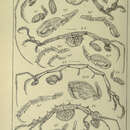en
names in breadcrumbs


Length: 20-30mm. Body tuberculation variable. Adult males: head with 1 pair tubercles, dorsal tubercles on pereonites 5 + 7. Antenna 1 flagellum longer than peduncle, peduncle articles 2 + 3 setose in males; antenna 2 shorter than peduncle of antenna 1, with long swimming setae. Gnathopod 1 propodus with one pair of proximal grasping spines; grasping margin of dactylus and propodus serrate. Gnathopod 2 propodus slender, palm with proximal projection bearing a spine, and with one or two accessory spines, and two distal projections; dactylus evenly tapered, may be setose in large adult specimens. Gills elliptical. Pereopods 5 - 7 propodus with proximal pair of grasping spines; dactylus long and slender.
Spitsbergen; Greelnad; Norway; Franz Joseph Land; Kara Sea; Faroe Islands
Caprellid, "Ghost" or "Skeleton" shrimps, so called for their skeletal appearance. Amphipod crustaceans, easily distinguished by the elongate stick-like body form and reduction of the abdominal appendages. Head is generally fused with pereonite 1. Pereopods on first 2 segments (pereonites) are most flexible and called gnathopods; gnathopods 2 being the largest, used in defense, feeding and substrate attachment. In many species pereopods 3 and 4 may also be reduced or absent. Gills on pereonites 3 + 4, rarely on pereonite 2. Pereopods 5 - 7 much smaller than 1 + 2, used for clinging to the substratum. In females, brood plates (öostegites) develop on pereonites 3 + 4. Much remains to be learnt about their biology, ecology and in many cases changing distributions.
128-329m
C. dubia and C. microtuberculata are very similar. In C. microtuberculata gnathopod 1 dactylus just reaches the end of the propodus palm, pereopod dactylus is long and slender; in C. dubia, gnathopod 1 dactylus reaches beyond the end of the propodus palm, pereopod dactylus is fairly short.